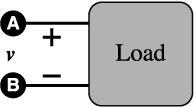Voltage Difference in Electric Circuit
Voltage difference is analogous
to pressure difference and is defined as
the differential amount of charge and energy
| |
 |
(3.5) |
Where dw
is the incremental energy required to move
an incremental charge dq
through a voltage difference
of V.
-
The voltage represents the greatest
difference of potential between any
two points in a circuit.
-
The voltage cannot flow; however,
it pushes current through the circuit.
-
Voltage must be present before current
can flow, just as pressure must be present
before water can flow.
-
Also, a voltage can exist between a
pair of electrical terminals whether
a current is flowing or not.
-
An automobile battery, for example,
has a voltage of 12 V
across its terminals even if nothing
is connected to the terminals.

Figure 3.1 A two-terminal
circuit.
The letter E
is used to indicate a voltage rise
and the letter V
is used to indicate a voltage drop.
A plus-minus pair of algebraic signs indicates
the sense of the voltage. The placement
of the + sign at terminal A
indicates that terminal A
is V
volts positive with respect to terminal
B
as (see Figure 3.1). If V
happens to have a numerical value of
–2 V,
then we may say either that A
is –2 V
positive with respect to B
or that B
is 2 V
positive with respect to A.
The sign also indicates the polarity
of a terminal, i.e. its particular
state (positive or negative).
|